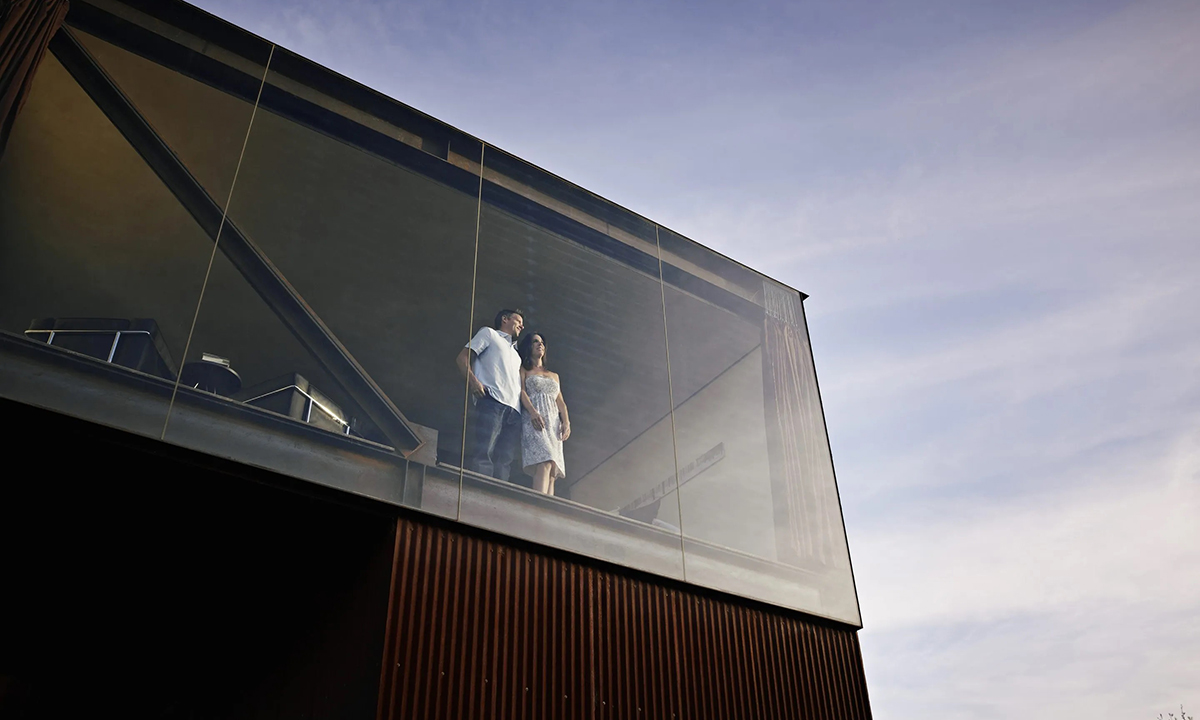
去年12月,《财富》杂志曾经在一篇文章中写道,我们正处于“美国房地产市场贫富分化的新时代”。时至今日,这句话放到一个单独的语境下似乎依旧成立。今年第二季度,豪宅价格创历史新高,但购买者依旧大有人在。
据Redfin统计,普通豪宅达到1,180,000美元的历史高价,同比增长约9%。这是近两年来的最大涨幅,而且增长速度是普通非豪宅房价增速的两倍以上。后者仅上涨了不到4%(但普通非豪宅的中位数房价依旧上涨至342,500美元,Redfin表示这是创纪录的高价)。
分析师称,第二季度,豪宅销量依旧有小幅上涨,但普通住宅销量下滑超过3%,成为“十年来销量最低的第二季度”。根据全美房地产经纪人协会(National Association of Realtors)的数据,今年6月份,百万美元以上豪宅的销量实际上同比有所上涨,但其他所有价位的住宅销量都出现了下滑。当然,整个房地产市场都已经不像疫情之前那么火爆,但豪宅市场的增长速度更快。
沃斯堡的一位Redfin房地产中介在分析报告中表示:“价格合理的高端住宅依旧有强劲的需求,特别是那些外观精美和可以拎包入住的房产。我们有一位客户最近挂牌出售一套240万美元的房产,最终售价为260万美元。如果一套住宅定价合理,外观吸引人,并且不需要任何装修,这种情况下我们依旧会收到多个出价。”
虽然每个人都能感受到高房价的影响,但快速上涨的抵押贷款利率对富人来说却不是障碍,因为他们全款买房。Redfin指出,在第二季度的大部分时间,抵押贷款利率高于7%,但对于全款买房的购房人来说,这毫无影响。今年春天,在截至5月的三个月,约44%的已售出豪宅均被全款买下(这个比例与去年基本相当)。此外,根据全美房地产经纪人协会的数据,6月全款购房的比例占总成交量的28%(与去年和上个月相比均没有太大变化)。
在城市层面,豪宅中位数售价涨幅最大的是普罗维登斯,其次是圣何塞和纽约州拿骚县。此外,豪宅销量增长幅度最大的是纳什维尔、坦帕和西雅图。但第二季度成交价最高的两套豪宅,位于科罗拉多州的度假城市格伦伍德斯普林斯,其中一套豪宅的成交价为7,700万美元。洛杉矶的一套豪宅成交价约6,300万美元,排在第三位。
Redfin高级经济学家谢哈里亚尔·博卡里表示:“豪宅市场经受住了今年高抵押贷款利率的影响,这得益于有大量购房人全款购房。随着销量趋于稳定和更多住宅挂牌待售,豪宅房价不太可能继续维持高速上涨。”不止豪宅,所有房产的库存都在增长,而且住宅在市场上的待售时间更长。一位来自奥兰多的Redfin中介表示:“海外现金买家依旧交易活跃,但我们看到本地买家的交易活动有所放缓。”
因此情况似乎正在发生变化。上周四发布的另外一份Redfin分析报告显示,普通住宅月供降至四个月来的最低点,而且如果随着通胀降温,抵押贷款利率继续下降,月供也将随之减少。平均30年期固定抵押贷款的周利率为6.78%(日利率略高)。
但人们依旧很难买得起一套普通住宅。根据Zillow的数据,今年6月,普通抵押贷款还款额比疫情之前增长了超过112%。在疫情引发的房地产市场繁荣期间,房价大幅上涨,而随着美联储为抑制通胀进行加息,抵押贷款利率也随之上涨。入门级住宅即将绝迹,而购买一套入门级住宅需要的工资水平,自疫情以来已经增长了近一倍。因此,尽管目前抵押贷款利率下降,房价上涨放缓,美国的房地产市场远远没有恢复到疫情之前的水平。
本月早些时候,奥巴马时期的美国住房与城市发展部部长、房地产非营利组织企业社区合作伙伴(Enterprise Community Partners)的首席执行官肖恩·多诺万在接受CNBC采访时表示:“我们刚刚度过了美国史上最严重的房屋可负担性危机。”在此之前,Redfin的高级经济学家赵晨(音译)表示:“买不起房是目前美国房地产市场的真实写照。”
上周的数据显示,6月现房销量环比和同比均有所下降;部分原因是抵押贷款利率锁定效应,潜在卖房人因为目前已经不存在的低抵押贷款利率而放弃卖房。另外一部分原因则是需求下降,而且我们看到由于需求下降,6月新房销量降至七个月最低。并非人们不需要房子;人们确实需要,但购房成本让他们望而却步,有些人甚至选择了毁约。只是对于富人而言,这些都不成问题。(财富中文网)
译者:刘进龙
审校:汪皓
去年12月,《财富》杂志曾经在一篇文章中写道,我们正处于“美国房地产市场贫富分化的新时代”。时至今日,这句话放到一个单独的语境下似乎依旧成立。今年第二季度,豪宅价格创历史新高,但购买者依旧大有人在。
据Redfin统计,普通豪宅达到1,180,000美元的历史高价,同比增长约9%。这是近两年来的最大涨幅,而且增长速度是普通非豪宅房价增速的两倍以上。后者仅上涨了不到4%(但普通非豪宅的中位数房价依旧上涨至342,500美元,Redfin表示这是创纪录的高价)。
分析师称,第二季度,豪宅销量依旧有小幅上涨,但普通住宅销量下滑超过3%,成为“十年来销量最低的第二季度”。根据全美房地产经纪人协会(National Association of Realtors)的数据,今年6月份,百万美元以上豪宅的销量实际上同比有所上涨,但其他所有价位的住宅销量都出现了下滑。当然,整个房地产市场都已经不像疫情之前那么火爆,但豪宅市场的增长速度更快。
沃斯堡的一位Redfin房地产中介在分析报告中表示:“价格合理的高端住宅依旧有强劲的需求,特别是那些外观精美和可以拎包入住的房产。我们有一位客户最近挂牌出售一套240万美元的房产,最终售价为260万美元。如果一套住宅定价合理,外观吸引人,并且不需要任何装修,这种情况下我们依旧会收到多个出价。”
虽然每个人都能感受到高房价的影响,但快速上涨的抵押贷款利率对富人来说却不是障碍,因为他们全款买房。Redfin指出,在第二季度的大部分时间,抵押贷款利率高于7%,但对于全款买房的购房人来说,这毫无影响。今年春天,在截至5月的三个月,约44%的已售出豪宅均被全款买下(这个比例与去年基本相当)。此外,根据全美房地产经纪人协会的数据,6月全款购房的比例占总成交量的28%(与去年和上个月相比均没有太大变化)。
在城市层面,豪宅中位数售价涨幅最大的是普罗维登斯,其次是圣何塞和纽约州拿骚县。此外,豪宅销量增长幅度最大的是纳什维尔、坦帕和西雅图。但第二季度成交价最高的两套豪宅,位于科罗拉多州的度假城市格伦伍德斯普林斯,其中一套豪宅的成交价为7,700万美元。洛杉矶的一套豪宅成交价约6,300万美元,排在第三位。
Redfin高级经济学家谢哈里亚尔·博卡里表示:“豪宅市场经受住了今年高抵押贷款利率的影响,这得益于有大量购房人全款购房。随着销量趋于稳定和更多住宅挂牌待售,豪宅房价不太可能继续维持高速上涨。”不止豪宅,所有房产的库存都在增长,而且住宅在市场上的待售时间更长。一位来自奥兰多的Redfin中介表示:“海外现金买家依旧交易活跃,但我们看到本地买家的交易活动有所放缓。”
因此情况似乎正在发生变化。上周四发布的另外一份Redfin分析报告显示,普通住宅月供降至四个月来的最低点,而且如果随着通胀降温,抵押贷款利率继续下降,月供也将随之减少。平均30年期固定抵押贷款的周利率为6.78%(日利率略高)。
但人们依旧很难买得起一套普通住宅。根据Zillow的数据,今年6月,普通抵押贷款还款额比疫情之前增长了超过112%。在疫情引发的房地产市场繁荣期间,房价大幅上涨,而随着美联储为抑制通胀进行加息,抵押贷款利率也随之上涨。入门级住宅即将绝迹,而购买一套入门级住宅需要的工资水平,自疫情以来已经增长了近一倍。因此,尽管目前抵押贷款利率下降,房价上涨放缓,美国的房地产市场远远没有恢复到疫情之前的水平。
本月早些时候,奥巴马时期的美国住房与城市发展部部长、房地产非营利组织企业社区合作伙伴(Enterprise Community Partners)的首席执行官肖恩·多诺万在接受CNBC采访时表示:“我们刚刚度过了美国史上最严重的房屋可负担性危机。”在此之前,Redfin的高级经济学家赵晨(音译)表示:“买不起房是目前美国房地产市场的真实写照。”
上周的数据显示,6月现房销量环比和同比均有所下降;部分原因是抵押贷款利率锁定效应,潜在卖房人因为目前已经不存在的低抵押贷款利率而放弃卖房。另外一部分原因则是需求下降,而且我们看到由于需求下降,6月新房销量降至七个月最低。并非人们不需要房子;人们确实需要,但购房成本让他们望而却步,有些人甚至选择了毁约。只是对于富人而言,这些都不成问题。(财富中文网)
译者:刘进龙
审校:汪皓
In December last year, Fortune wrote we were in the midst of “a new American era of housing haves and have-nots.” It still seems to hold true today, maybe in a separate context. Luxury-home prices hit an all-time high in the second quarter of the year, and yet people are still buying them.
The typical luxury home sold for a record $1,180,000, an increase of almost 9% from a year earlier, according to Redfin. It was the greatest leap in close to two years, and happens to be more than twice as fast as non-luxury, typical home prices, which only rose under 4% (although still to what Redfin called a record-high median of $342,500).
And still, luxury-home sales rose in the second quarter, albeit slightly, while normal-home sales fell more than 3% to the “lowest second-quarter number in a decade,” the analysis read. In June, according to the National Association of Realtors, sales for million-dollar-plus homes actually rose from a year ago, whereas all other price categories saw their sales decline. Of course, the entire housing world is seeing less bustle than before the pandemic, but the luxury corner looks to be moving faster.
“There is still strong demand for well-priced, high-end properties, especially those which are presented beautifully and [are] move-in ready,” a Redfin agent in Fort Worth said in the analysis. “We had a client recently list a property for $2.4 million that we ended up selling for $2.6 million. We are still seeing multiple offers in situations where a property is priced accurately, [is] visually appealing, and doesn’t need any work.”
And while everyone feels the effects of sky-high home prices, soaring mortgage rates are no obstacle for the wealthy, for a particular reason: all-cash. For most of the second quarter, as Redfin points out, mortgage rates were higher than 7%, but it didn’t matter if you paid in cash. This spring, in the three months ended in May, almost 44% of luxury homes sold were purchased with all cash (not much of a difference from last year, by the way). Separately, according to the National Association of Realtors, all-cash sales accounted for 28% of transactions in June (also not much of change from last year or the prior month).
On a metro level, the median sale price of luxury homes rose most in Providence, followed by San Jose, and Nassau County, N.Y. Meanwhile, luxury-home sales increased the most in Nashville, Tampa, and Seattle. But the two most expensive homes sold in the second quarter were in Glenwood Springs, a resort city in Colorado; one cost as high as $77 million. Los Angeles had the third-most costly sale, at about $63 million.
“The luxury market has withstood the havoc wreaked by high mortgage rates this year, thanks to an abundance of all-cash buyers,” noted Redfin senior economist, Sheharyar Bokhari. “Now that sales are stabilizing and more homes are being listed for sale, it’s unlikely that luxury prices will continue to grow at quite as high a rate.” All inventory is increasing, luxury or not, and homes are staying on the market longer. An Orlando-based Redfin agent said, “international cash buyers are still driving activity, but we have seen a slowdown in local buyers.”
So things are changing, it seems. Another Redfin analysis out Thursday showed typical monthly housing payments fell to their lowest point in four months, and if mortgage rates continue to decline as they have on the back of cooler inflation, payments will, too. The weekly average 30-year fixed mortgage rate came in at 6.78% (daily rates are a bit higher).
Still, it isn’t easy to afford an ordinary home. In June, according to Zillow, the typical mortgage payment increased by more than 112% since before the pandemic. Home prices went up substantially during the pandemic-fueled housing boom and mortgage rates followed, once the Federal Reserve raised interest rates to tame inflation. Starter homes are going extinct, and the salary needed to buy one has almost doubled since the pandemic. So even now that mortgage rates are falling and home prices are rising at a slower pace, we’re nowhere near our pre-pandemic housing market.
Earlier this month, Shaun Donovan, former U.S. Secretary of Housing and Urban Development in the Obama era and chief executive of housing nonprofit Enterprise Community Partners, said in an interview with CNBC: “We’re just coming through the worst housing affordability crisis we’ve ever seen in this country.” Before that, Redfin senior economist, Chen Zhao, said: “Unaffordability is really the story in the housing market right now.”
Just this week, data showed existing-home sales fell on a monthly and annual basis in June; part of that is still the lock-in effect in play, as would-be sellers cling to their homes for their low, or nonexistent, mortgage rates. The other part is that demand is off, and we saw exactly that with new-home sales, as well, which declined to a seven-month low in June. It isn’t that people don’t need homes; they clearly do, but that cost is deterring them from buying, to the extent that some are even backing out of deals. Only that doesn’t seem to be the case for the wealthy.






